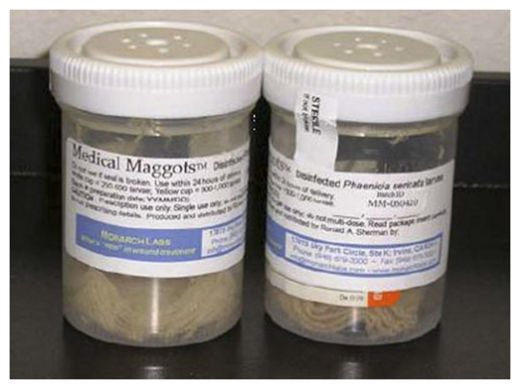
© Monarch Labs via Bloomberg Medical-grade maggots are fly larvae grown in a lab and germ-free.
Maggots healed the wounds of diabetic patients where traditional medicine had failed, according to a report that suggests the ancient therapy may offer an alternative for clearing severe ulcers.
Medical-grade versions of the fly larvae, placed on the sores of 27 diabetic patients, helped close the wounds in 21 cases, said Lawrence Eron, associate professor at the University of Hawaii's
John A Burns School of Medicine, in Honolulu, and an author of the report. Some of the wounds had been open for as long as five years, he said.
Maggot therapy, a medical technique since Biblical times, declined after antibiotics came into use in the 1940s. The treatment is now undergoing a resurgence as a potential cheap alternative for patients with wounds infected with drug- resistant bacteria. The findings were presented today at the Interscience Conference on Antimicrobial Agents and Chemotherapy, in Chicago.
"There's this yuck factor that permeates not only patients' views of using maggots, but especially the medical profession -- and I was no exception to that," Eron said in a telephone interview. "But when I saw the results of what these maggots do, and what they accomplished, I became very enthusiastic."
Maggot MysteryHow exactly the maggots accomplished this feat is still being studied, Eron said.
"There are substances secreted in their excretions that have very interesting properties," he said, including an anti- bacterial effect and the ability to stimulate patients' immune systems, as well as angiogenesis, or the growth of new blood cells.
"Taking advantage of them without knowing too much about how they work, we used this on our toughest patients," Eron said.
Diabetes afflicts 366 million people worldwide, killing one every seven seconds, according to the International Diabetes Federation. The disease can damage nerve endings and restrict blood flow, often leading to wounds that get infected. Treatments range from antibiotics to amputation, in more serious cases. As many as 33 percent of people with diabetes will have a skin disorder at some point in their lives, the
American Diabetes Association says.
One patient in Eron's study, whose gangrene was so severe doctors wanted to amputate his infected leg, chose instead to try maggots. After several months, his gangrene receded and his limb was saved, Eron said.
Curative PowersWhile maggots have been known to clean wounds, the result of this study showed they have curative powers as well. A study published in 2009 in the British Medical Journal, however, showed maggots were no better than a commonly used gel to heal wounds.
The study, conducted without funding at the Kaiser Hospital in Honolulu, used the larvae of the green bottle fly, purchased from Irvine, California-based
Monarch Labs LLC. The treatments cost $100 for a two-day supply, and results were seen after 10 days, on average. Traditional treatments for an uninfected diabetic foot ulcer can cost between $7,000 to $10,000, or an amputation at $65,000, the report said.
Twenty-five laboratories around the world shipped 50,000 treatments last year for use in patients in 30 countries, according to Ronald Sherman, laboratory director for Monarch, the only U.S. provider of therapeutic maggots.
Laboratory Fly LarvaeMedical-grade maggots are fly larvae grown in a lab and germ-free. Maggots eat only diseased tissue, and have probably been used as a remedy for infected wounds for thousands of years, Eron said. A
passage in the Bible mentions Job's broken skin is "clothed with worms," he said.
One of the earliest European medical texts,
Hortus Sanitatus, mentioned the use of maggots when it was published in Germany in 1491. Research conducted by William Baer, a professor of orthopedic surgery at Johns Hopkins University School of Medicine in Baltimore, showed the success of the treatment during World War I.
Their use started to fall out of favor in the late 1930s and early 1940s when antibiotics became more prevalent, according to the U.S. Food and Drug Administration. The agency approved their use as an unclassified medical device in 2004.
Eron said it will be at least a decade before scientists can figure out the exact properties in the larvae secretions and create medicines from them. The development of such therapies could provide a solution to the growing number of germs that have become resistant to antibiotics. Still, Eron said people shouldn't try this at home with maggots found in compost bins or other dirty areas.
"That may have been how they did things in Biblical times, or by the Mayan civilization," he said, "but I would not do that."
That just goes to show that nature has an answer for everything and is never wasteful. Even though, I'd still like to be curing the diabetes, rather than treating the symptoms. 50% of all below knee amputations are because of diabetic ulcers.
Unfortunately it may depend on the type of bug that gets in there, too. Somebody with gas gangrene caused by clostridium infection probably doesn't have the time or the choice to keep his/her leg. Not good.